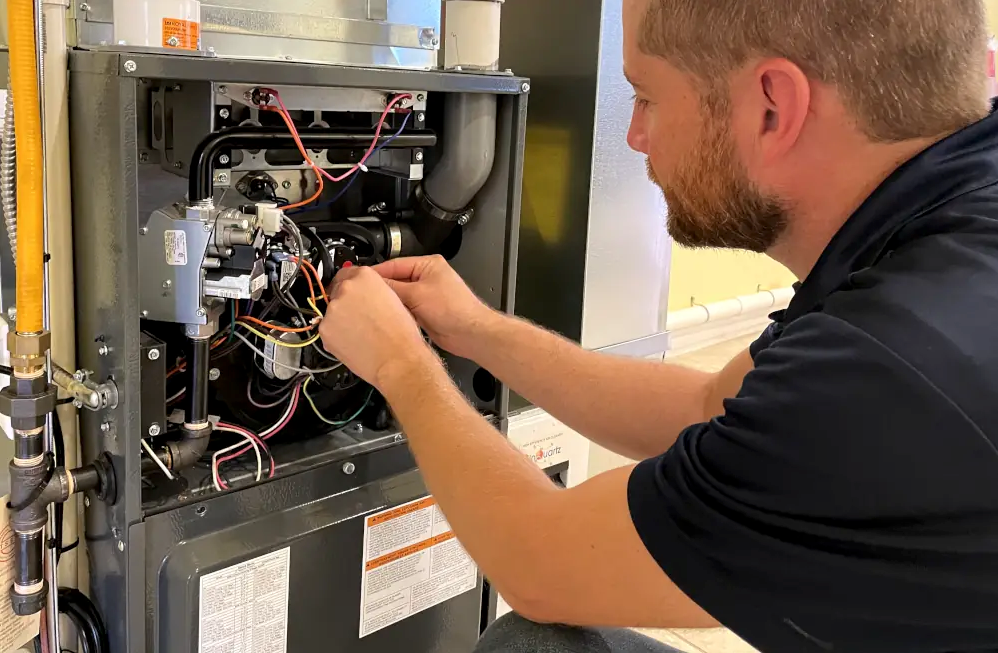Like most people, you do not think about cleaning your furnace as long as it’s still working and can keep you warm during the winter months. However, this is a critical task that is often overlooked. A clean filter improves your furnace’s efficiency, promotes better air quality, and extends the life expectancy of your heating system.
How Often Should You Change Your Furnace Filter?
The general rule of thumb is to change your furnace filter every 1-3 months, even if you live in cold areas. However, there are some specific situations where you may need to change it more frequently, including:
- Allergies or respiratory issues: If anyone in your household has asthma, allergies, or other respiratory problems, you may want to change the filter more frequently to ensure cleaner air. According to a study from ACAAI, some air cleaners can actually irritate your allergies, not help them. Inexpensive fiberglass furnace filters can do more harm than good if not changed.
- Pets: If you have pets in your home, especially ones that shed a lot, their fur can quickly clog up a filter. In this case, changing the filter every 1-2 months is recommended to prevent any buildup that could affect the efficiency of your furnace.
- Smoking: If anyone in your household smokes indoors, this can also lead to faster buildup on the filter. Changing it every month is best to keep the air as clean as possible.
Three Popular Types of Filters Commonly Used in HVAC Systems
Each type offers different levels of filtration, efficiency, and maintenance requirements. Below are the durations for how often you should change them.
- Fiberglass filters: (30 Days)—This is the most basic and affordable option, but it requires replacement every 30 days.
- Pleated filters: (60–90 Days)—This type is made from synthetic materials and traps smaller particles such as pollen and mold spores. It requires replacement every 60–90 days.
- HEPA filters: (Every 6–12 months, depending on the manufacturer’s recommendation)—this type is the gold standard of filters due to its efficiency in capturing 99.97% of particles down to 0.3 microns in size (according to the EPA).
However, during heavy furnace use in the fall and winter, checking your filter once a month is a good practice to ensure optimal performance.
How to Change Your Furnace Filter: Essential Step-by-Step Guide
Step 1: Turn Off the Furnace
Turning off the furnace for safety is crucial before doing any maintenance. Most furnaces have a power switch near the unit, or you can switch off the circuit breaker that controls the furnace.
Step 2: Locate the Furnace Filter
The furnace filter is usually located near the intake air blower compartment, inside the furnace, or in the return air duct. If you are unsure where your filter is located, refer to your furnace’s user manual or look for a panel that says “Filter” or “Air Intake.”
Step 3: Remove the Old Filter
Carefully slide out the old filter. Pay attention to the direction of the airflow arrows printed on the filter. These arrows show the correct installation direction, which will be important when you insert the new filter.
Inspect the old filter. If it’s clogged with dust and debris, it’s time for a replacement. If it’s only lightly dirty, you may decide to keep it for another month, but in general, it’s safer to replace it regularly.
Step 4: Insert the New Filter
Grab your new furnace filter and insert it into the slot, ensuring that the airflow arrows point in the same direction as the old filter. The arrows should point toward the furnace (in the direction the air is flowing).
Step 5: Secure the Panel and Turn the Furnace Back On
If you had to remove any panels or screws to access the filter, reattach them securely. Then, turn your furnace back on by flipping the power switch or resetting the circuit breaker. Your furnace should now operate more efficiently with the new filter!
Basic DIY Furnace Maintenance Tips
- Inspect Your Furnace Regularly: Even after replacing the filter, it’s a good idea to visually inspect the furnace for any unusual noises, odors, or leaks.
- Schedule Professional Maintenance: Schedule a professional inspection and tune-up for your furnace once a year, preferably in the fall, to catch any potential issues before the heating season starts.
- Check Your Thermostat: Ensure your thermostat is functioning properly and set to an efficient temperature. Consider upgrading to a programmable thermostat to save on energy costs.
- Seal Leaks in Ductwork: Leaks in the ductwork can cause heated air to escape, reducing your furnace’s efficiency. Have a professional inspect and seal any leaks to optimize performance.
Why Does This Matter?
Ultimately, checking your furnace filter regularly and replacing it as needed is key to maintaining good indoor air quality and preventing unnecessary strain on your heating system. By keeping up with this simple maintenance task, you can ensure that your furnace operates efficiently and effectively all year round.
If you need help and want to make this a priority this season, book a call today, and we’ll inspect your furnace before the winter months!

